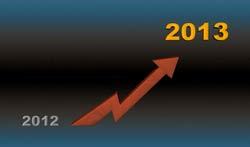Global growth expectations for 2013 and 2014 have been revised to below expectations with real GDP growth for the world now expected at 3.0 percent in 2013 and 3.8 percent in 2014 from 3.1 percent in 2012, according to Craig Pheiffer, head of Private Client Asset Management at Absa.

Marriott Asset Management says for investors to achieve adequate levels of income and to grow their assets, they should invest in assets which demonstrate growth in income.
Pheiffer says developed economies which contribute half of the global economy on a purchasing power parity basis are expected to grow at a rate of 1.0 percent in 2013 and 1.9 percent in 2014 from 1.2 percent in 2012.
In South Africa, he says the current low rate of economic growth can partially be attributed to the slow rate of growth in the global economy.
“Slowing growth in China and recessionary conditions in Europe, two of the largest importers of our goods, have hurt exports and domestic manufacturing production.”
Pheiffer says slower global growth has also translated into a lower demand for commodities and commodity prices have fallen.
Furthermore, he says lower domestic economic confidence and business confidence in an uncertain global and domestic environment has meant that consumers have postponed purchases of big ticket items while business has postponed expansion and hiring plans – adding to the general slowdown.
“The highly indebted nature of households has exacerbated the situation in that even in a historically low interest rate environment, consumers are running out of capacity to borrow more (and hence demand for more goods and services),” he says.
As a result, Pheiffer says the production side of the economy is weak.
Absa is of the view that the South African economy will grow at 2.3 percent in 2013 and does not foresee rate cuts anytime soon.
Some economists also expect interest rates to remain unchanged at 5 percent this week.
“In a low growth environment with inflation contained at the upper end of the South African Reserve Bank’s target range, it is likely that interest rates will be maintained at their current low level well into 2014,” says Pheiffer.
Taxes and unemployment
Annabel Bishop, Investec chief economist, says the Finance Department has warned that if revenue collections don’t meet the target in the budget, tax hikes cannot be ruled out.
“Hiking taxes while the economy is weak would be procyclical, causing economic growth to slow even further (and unemployment to rise) by using contractionary fiscal policy,” she points out.
Bishop says tax hikes impose fiscal tightening on an economy by cutting disposable incomes and slowing economic growth - consumers have less to spend and corporates less to invest following tax hikes, a similar but typically more severe effect to hiking interest rates, both of which reduce employment.
The resulting economic slowdown in turn reduces tax revenues, countering the initial benefits from the tax increase, she says.

Global growth expectations for 2013 and 2014 have been revised to below expectations with real GDP growth for the world now expected at 3.0 percent in 2013 and 3.8 percent in 2014, from 3.1 percent in 2012, according to Craig Pheiffer, head of Private Client Asset Management at Absa.
In weak growth (revenue) periods persistently elevated expenditure results in higher debt levels.
SA has seen public sector debt climb from 27.4 percent of GDP in 2009/10 to 36.3 percent in 2012/13 on a net basis (less cash balances of the National Revenue Fund at the Reserve Bank and other commercial banks) and it is projected to reach 40.3 percent of GDP by 2015/16.
“Faster economic growth resulting from tax cuts benefits employment creation, in contrast increased government expenditure tends to temporarily boost growth but longer term increases the size of the government sector and can slow economic activity.”
She explains that since the start of 2009 the private sector has lost 289 000 jobs and the government sector created 240 000, but on a net basis the economy is down 49 000 jobs since the end of 2008 and government’s financial capacity to create yet more positions for civil servants without undermining the sustainability of its finances has run out.
“Rapidly rising civil servant remuneration (both due to more employees and higher real wages) and expanding social services have been key drivers of countercyclical fiscal policy in SA, swelling the size of government and appeasing the populous.”
Bishop says South Africa’s unemployment rate is 25.2 percent, well up from 21.8 percent at the end of 2008.
Higher income tax rates eventually result in higher unemployment (as consumer spending falls) and this is particularly pertinent for South Africa as households are already being squeezed by rising living costs due to the rapid escalation in electricity tariffs, and to only a somewhat lesser extent, higher water tariffs and property rates and taxes.
“Higher taxes would mean households are likely to seek to reduce costs, given low saving levels and significant debt service costs, shedding or reducing the hours of domestic workers in scaling back to necessities.”
In SA 14.2 percent of employed women are domestic workers and higher income taxes would likely significantly increase both unemployment and underemployment.
“South Africa is not a high income country and so does not have a sufficient number of tax payers to support a high tax to GDP ratio as there are simply not enough people paying taxes.”
According to Bishop, in SA 1 percent of the population (8.4 percent of taxpayers) pay 53.8 percent of income tax, in the United States 30.2 percent pay income tax (2008 tax year, published 2011), in the United Kingdom 48 percent pay income tax, (2012-13 estimate), in Australia 43 percent pay income tax (2009-10).
National Treasury estimates that only 2.3 percent of South African taxpayers earn over R1 million per annum but pay 30.4 percent of income tax. 16 million South Africans receive social welfare monetary grants.
This number is expected to rise to 17.2 million in 2015/16, with 12 million children but risks entrenching a culture of dependency without employment opportunities to absorb those who wish to work.

“If you’re going to panic, do it early and if you missed the panic, there’s no point doing it now,” says Christopher Gilmour, investment analyst at Absa.
“It is also pertinent to note that the total cost of the social wage (grants, education, health and housing and community amenities) is 59 percent of total annual government expenditure,” says Bishop.
She notes that tax cuts are unlikely, which means the burden will likely fall to monetary policy to stimulate economic activity in the weak growth environment - the chance of an interest rate cut this year is increasing.
Investing money
Christopher Gilmour, investment analyst at Absa says for investors who missed the boat, it’s too late to panic, the worst in the markets may very well be over.
“If you’re going to panic, do it early and if you missed the panic, there’s no point doing it now,” he says.
He explains that the Johannesburg Stock Exchange (JSE) All Share Index declined by 5.70 percent in June, the All Bond Index fell 1.52 percent for the month with the inflation-Linked Bond Index down 5.47 percent.
The Top 40 was down 6.7 percent in June but damage was minimal on a three month view (down 0.2 percent) with some sub sectors facing severe pressure.
Gold mining shares lost 19.75 percent in June and were 33.5 percent down over the second quarter, he says.
June’s top performers were fixed line telecoms up 11.4 percent and Pharmaceuticals and Biotechnology +6.8 percent.
“Although some June figures look grim, the correction brings the market back to reality and there’s a good cause to stick around and enjoy the market gains driven by improved economic fundamentals rather than the unrealistic expectation that artificial stimulus will continue forever.”
He says South Africans dependent on fixed income remain under pressure as interest rates will probably remain low, though the prospect of a further cut has receded.
“Equities offer the best chance of inflation-beating returns and the good news after the June sell-off is that astute stock-pickers should be able to identify value and pursue renewed growth.”
Gilmour notes that investors have bought quality stocks for the longer term, pushing valuations up as deep value in quality stocks is increasingly difficult to find.
He says retail sales growth looks vulnerable to local input shocks such as the weaker rand and higher food, fuel and administered prices.

According to Bishop, In SA 1 percent of the population (8.4 percent of taxpayers) pay 53.8 percent of income tax, in the United States 30.2 percent pay income tax (2008 tax year, published 2011), in the United Kingdom 48 percent pay income tax, (2012-13 estimate), in Australia 43 percent pay income tax (2009-10).
“Our favourite retail stocks remain Mr Price, Shoprite and Woolworths, while the African growth story should continue to sustain many retail shares,” according to Gilmour.
He says the weaker rand should help hedge stocks such as BAT, SABMiller and Richemont, while other stocks that should benefit from the weaker rand include Sasol and tourist-related such as City Lodge and Tsogo Sun.
“We see a very dim outlook for gold mining stocks and even the gold ETF has lost its lustre.”
Gilmour notes that conglomerate stocks such as Imperial, Barloworld, Bidvest (although better situated than others) and Remgro may find it difficult to perform against a relatively weak economic background.
Meanwhile, Marriott Asset Management says for investors to achieve adequate levels of income and to grow their assets, they should invest in assets which demonstrate growth in income.
“This means that fixed income assets, such as cash, are less desirable than equity and property.”
Marriott explains that constructing a portfolio for future income involves determining an investor’s risk tolerance and recognising that investment risk lies with income growth.
Unlike income yield, which is known at the time of investment, income growth is less predictable, therefore, capital accumulation by re-investing income is a more certain and predictable way of increasing the size of an investment.
Over the longer term, capital value growth resulting from income growth will generally produce a greater increase in investment value.
The managers say the extent to which investors draw down capital to sustain an income level or a particular lifestyle, will impact significantly on future income levels as well as capital growth and capital preservation.
To succeed, the managers have advice for investors:
1. The best route to achieve success is to focus on income and let the capital take care of itself,
2. Capital drawdowns should be avoided as far as possible, to preserve the level of capital and to provide for income in future periods, and
3. Reinvest as much income as possible to ensure capital accumulation.
Property and equities
Marriott says an advantage of property and equity investments is their growth in income streams.
“In the case of property, if its income wasn’t able to grow, its income nature would be very similar to bonds.”
However, the managers say there is additional risk associated with acquiring and retaining tenants, as well as general business risks (since the properties are housed in a company structure), so property investments need to yield more to compensate for this additional risk.
“Equities are also able to grow income over time and the value of a company rises at the rate at which its profit grows.”
The value of an investment grows over time at the rate at which its income grows and investments that grow their income will increase the value of a portfolio over time, they explain.
According to Marriott, by combining high yielding investments (bonds) with investments that have the ability to grow their income (equities), it is possible for an investor to attain a reasonable level of income with inflation-hedged income and capital growth.
The income can be used to fund a lifestyle or can be reinvested to accumulate more capital, they add. – Denise Mhlanga









